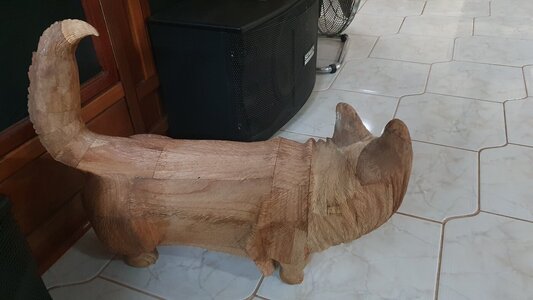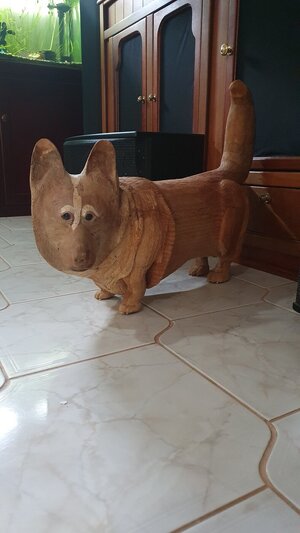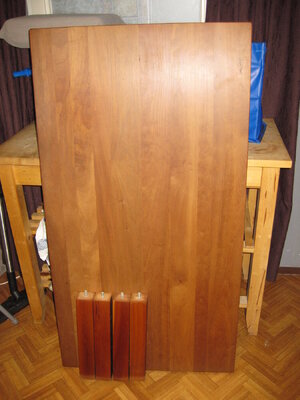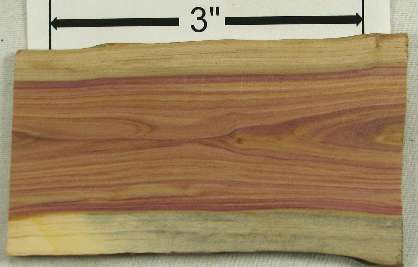For me, the most daunting thing is getting useful plans and drawings to start with. I can mill wood, print hardware, and can even make my own rope but getting plans that I could translate to useable pieces is a tough item....
You are using an out of date browser. It may not display this or other websites correctly.
You should upgrade or use an alternative browser.
You should upgrade or use an alternative browser.
For me it was a matter of having all the seasoned timber I needed from our farm, basic woodworking and metalworking skills, a good range of tools, access to a great community workshop and a desire to build something unique and meaningful to me. Plus being diagnosed with metastatic cancer and having to sell the farm focused my mind on the time I have left to achieve something that pleases me.
As my ship is a sister to HMS Enterprise (1774) there were plenty of kits and plans available to refer to so I just launched into it. I had little idea what I was doing and had only ever built one kit model (a plastic Victory when I was a child) but I joined SOS as soon as I started this project and the tips, advice, humour and constructive criticism I have received has kept my interest up.
I've made many blunders, taken short cuts, re-built parts that annoy me and enjoyed almost every moment of the past 4 + years. So "Scratch building" was definitely the right decision for me personally, but if you want a museum quality build you will need a lot more experience that I had.
Good luck to us all, I say. Build a kit, scratch build, kit bash or buy a ready-built model. So long as it gives you joy then it is the right decision.
As my ship is a sister to HMS Enterprise (1774) there were plenty of kits and plans available to refer to so I just launched into it. I had little idea what I was doing and had only ever built one kit model (a plastic Victory when I was a child) but I joined SOS as soon as I started this project and the tips, advice, humour and constructive criticism I have received has kept my interest up.
I've made many blunders, taken short cuts, re-built parts that annoy me and enjoyed almost every moment of the past 4 + years. So "Scratch building" was definitely the right decision for me personally, but if you want a museum quality build you will need a lot more experience that I had.
Good luck to us all, I say. Build a kit, scratch build, kit bash or buy a ready-built model. So long as it gives you joy then it is the right decision.
Last edited:
- Joined
- Jan 15, 2021
- Messages
- 48
- Points
- 93

I consider my last 2 builds, HMS Surprise and HMS Bellona as "scratch" builds as I started by sourcing plans and images for construction from books from the "Anatomy of the Ship" series and material available online.
Plans for hull construction were then developed and the hull was built by scroll saw cutting profiles followed by 2 layer planking. I am unable to fabricate the planks so they are purchased from a specialist supplier.
As an architect I am used to the creation of 3 dimensional objects from drawings so hull construction is a good challenge and very satisfying when it works out.
When it comes to small numerous items like cannon barrels and dead eyes which are either impossible for me to make or just unbelievably time consuming and fiddly I am happy to buy these items. Because there are so many of them I do make most of my own blocks. I buy rigging cord in as many sizes as I can but I make up the larger ropes such as the main stay on a rope walk.
I think the lack of any "to scale" drawings or instructions or major prefabricated hull parts are essential in scratch building.
Plans for hull construction were then developed and the hull was built by scroll saw cutting profiles followed by 2 layer planking. I am unable to fabricate the planks so they are purchased from a specialist supplier.
As an architect I am used to the creation of 3 dimensional objects from drawings so hull construction is a good challenge and very satisfying when it works out.
When it comes to small numerous items like cannon barrels and dead eyes which are either impossible for me to make or just unbelievably time consuming and fiddly I am happy to buy these items. Because there are so many of them I do make most of my own blocks. I buy rigging cord in as many sizes as I can but I make up the larger ropes such as the main stay on a rope walk.
I think the lack of any "to scale" drawings or instructions or major prefabricated hull parts are essential in scratch building.
I can recognize already some frames and four masts - so you plan to build a four-masted clippership in POF?Scratch kits are available on the second hand market. I bought this cherry wood kit of a Dutch 2 decker.
View attachment 447372
It was very cheap and only cost 15 euro.
Why so complicated Steef?
Call it a raft at scale 1:4 and Bob's your uncle;-)
Call it a raft at scale 1:4 and Bob's your uncle;-)
- Joined
- Aug 8, 2019
- Messages
- 4,264
- Points
- 688

One is for spare. In scratch you need a lot of spare parts, no problem, they're cheap.I can recognize already some frames and four masts - so you plan to build a four-masted clippership in POF?
- Joined
- Oct 11, 2020
- Messages
- 23
- Points
- 48

The term "Scratch Building" is open to various interpretations by people depening upon thier viewpoint, thus the term can have a variety of meanings.
In the usual meaning regarding model building of any type it can mean either of the following:-
1) Building from an existing plan and making all of the parts using materials available from the usual suppiers. ie sheet materials, and NO pre-cut parts'
2) building the model as in 1 (above) but researching the original ship form books and/or museums then scaling out a the dimension from the full size, then drawing the model assembly and parts prior cutting all components from sheet materials, and planking form the usual sources.
I chuckled when I read reference to cutting the tree down or even growing the tree, I doubt that any of us would live long enough to plant and grow a tree with the intention of harveting for model making. Doubtless somebody on here will prove me wrong on that!
I started with a kit, "The Endeavour" for my first model built exactly to the kit instructions/drawings.
Now "Kit Bashing" the Mary Rose by using the kit hull with a scratchbuilt superstructure to the original build design.
I am thinking of scratch building HMS Lenox by making my own drawing from diagrams in a book on the vessel.
An example of scratchbuilding, the model railway locomotive in my profile picture was designed and build by myself, and I made around 10 of these to different designs and types. Now days they are just too large and heavy for me to manage, which is why I now build model ships.
In the usual meaning regarding model building of any type it can mean either of the following:-
1) Building from an existing plan and making all of the parts using materials available from the usual suppiers. ie sheet materials, and NO pre-cut parts'
2) building the model as in 1 (above) but researching the original ship form books and/or museums then scaling out a the dimension from the full size, then drawing the model assembly and parts prior cutting all components from sheet materials, and planking form the usual sources.
I chuckled when I read reference to cutting the tree down or even growing the tree, I doubt that any of us would live long enough to plant and grow a tree with the intention of harveting for model making. Doubtless somebody on here will prove me wrong on that!
I started with a kit, "The Endeavour" for my first model built exactly to the kit instructions/drawings.
Now "Kit Bashing" the Mary Rose by using the kit hull with a scratchbuilt superstructure to the original build design.
I am thinking of scratch building HMS Lenox by making my own drawing from diagrams in a book on the vessel.
An example of scratchbuilding, the model railway locomotive in my profile picture was designed and build by myself, and I made around 10 of these to different designs and types. Now days they are just too large and heavy for me to manage, which is why I now build model ships.
In England, yes. In sub-tropical Queensland, a piece of cake. We planted Silky Oak in 1980, harvested it 17 years later and had ceiling to floor bookcases made from it.I chuckled when I read reference to cutting the tree down or even growing the tree, I doubt that any of us would live long enough to plant and grow a tree with the intention of harveting for model making. Doubtless somebody on here will prove me wrong on that!
I
The Jacaranda I am using was planted in 1982 and we harvested it in 2001.
The olive, persimmon, red cedar and Queensland Maple were all planted since 1982 and branches harvested before 2015.
The Silver Ash was a 30 year old tree on our fence line which we harvested in 2005. The black wattle (Acacia) is an excellent timber, grows wild in the region and has a life span of about 30 years.
We left a thousand Gympie Messmates (eucalyptus) on our farm in 2019 which were planted in 1996 and most were ready for harvest as power poles.
None were grown with the intention of model making but they were grown with the intention of using them or selling them in my lifetime. Model building came as a result of my downsizing from the farm and having a strong interest in the 18th century navy.
What I love about this forum is the diversity of our members and their locations around the world. All drawn together by a love of model ships.
Love it!in a kit build you get a thousand pieces already pre formed for you, the attached picture is of the thousand pieces in a scratch build, you just need to cut them out
View attachment 447020
Love the humour! - I've even used old floor boards and granny's wardrobeScratch kits are available on the second hand market. I bought this cherry wood kit of a Dutch 2 decker.
View attachment 447372
It was very cheap and only cost 15 euro.
- Joined
- Aug 8, 2019
- Messages
- 4,264
- Points
- 688

Love the humour! - I've even used old floor boards and granny's wardrobe

Neither was I !
I actually did use mahogany floorboards and Granny's old wardrobe - have a look at 'Natterer' below.
Regards
Ted
Hi Ian, I agree with you fully although for my first build, I will use Cherry I have purchased but we do have access to a lot of timber in Australia that we can machine to what we want.In England, yes. In sub-tropical Queensland, a piece of cake. We planted Silky Oak in 1980, harvested it 17 years later and had ceiling to floor bookcases made from it.
The Jacaranda I am using was planted in 1982 and we harvested it in 2001.
The olive, persimmon, red cedar and Queensland Maple were all planted since 1982 and branches harvested before 2015.
The Silver Ash was a 30 year old tree on our fence line which we harvested in 2005. The black wattle (Acacia) is an excellent timber, grows wild in the region and has a life span of about 30 years.
We left a thousand Gympie Messmates (eucalyptus) on our farm in 2019 which were planted in 1996 and most were ready for harvest as power poles.
None were grown with the intention of model making but they were grown with the intention of using them or selling them in my lifetime. Model building came as a result of my downsizing from the farm and having a strong interest in the 18th century navy.
What I love about this forum is the diversity of our members and their locations around the world. All drawn together by a love of model ships.
I do have in my wood shed also Jacaranda which was "harvested" - cut down from right next door. I offered to take the tree down for them and have the wood drying in the shed as I write. I had to make more strakes on my first small model as I did not want to follow the Model supplier's ideas on the hull cladding as it was messy, and it worked out perfectly using Pine wood thinned down to 1.5 mm and with hot water, they did not crack. I have heard pine is not a good wood, but it did the trick for me.
I would like to try Jarrah if there is a spot for it on the build as well. It also goes well when steamed when it is machined to small strips. I guess I need to find that out.
Good material is where you find it. . .
I'm going to be taking an old lilac tree down...I wonder what lilac wood might be like....Good material is where you find it. . .
Hi GaryHi Ian, I agree with you fully although for my first build, I will use Cherry I have purchased but we do have access to a lot of timber in Australia that we can machine to what we want.
I do have in my wood shed also Jacaranda which was "harvested" - cut down from right next door. I offered to take the tree down for them and have the wood drying in the shed as I write. I had to make more strakes on my first small model as I did not want to follow the Model supplier's ideas on the hull cladding as it was messy, and it worked out perfectly using Pine wood thinned down to 1.5 mm and with hot water, they did not crack. I have heard pine is not a good wood, but it did the trick for me.
I would like to try Jarrah if there is a spot for it on the build as well. It also goes well when steamed when it is machined to small strips. I guess I need to find that out.
I have used jacaranda extensively throughout my build as it is close grained, light and can be worked down to 2mm or less without splitting or warping. My tree was cut into 300x300mm billets and the ends painted. They were air dried under cover for 15-17 years and although there was some splitting I have salvaged more than enough for my use.
I think it can be of some use, but regarding twisting, you would have to wait and see how it performs. I actually had a fairly large section given to me which was laying out in the open for about 15 years and then I cut it up and then machined down to usable sizes. I was surprised by how it handled the carving process.I'm going to be taking an old lilac tree down...I wonder what lilac wood might be like....
Here is a carving of my since-passed Corgi dog and I have used over 10 types of wood.
This carving has taken me ten years and have done numerous YouTube videos on this carve.
If anyone is interested I have a lot of videos on my channel regarding everything I do.. I use it as a log to record what I have done in my life. Believe me, I have done many things over my lifetime and still want to keep on going and doing more...
Anyone interested in my Channel then it is GaryPArmstrong and when googling just copy and paste my channel name in the search line. Like and subscribe to get my latest if you like
My site is not receiving any money or sponsors as I just do it for fun and to keep myself alive brain-wise as it would be so sad to let go of my ability to create.


All the wood over his midframe is lilac.
Please understand this carving is hollow and holds his ashes in a box designed to fit inside and has taken over 5 years to build. The carve is 750mm x 550mm high and 250mm in width.
Building this carving took a lot of work not similar to building a model ship I would guess.... Hmm
Hi Ian, Actually in the carving world I do belong to, they say the Jacaranda tree belongs to the Rosewood family.Hi Gary
I have used jacaranda extensively throughout my build as it is close grained, light and can be worked down to 2mm or less without splitting or warping. My tree was cut into 300x300mm billets and the ends painted. They were air dried under cover for 15-17 years and although there was some splitting I have salvaged more than enough for my use.
I have also heard it is classed as a weed in Queensland in some parts as it grows prolifically and out of control. is that true?
They are a Beautiful tree when in flower also. We have a lot of areas around Perth with them in backyards. I secretly think to myself "Fall over and I will cut you up".
Many years ago I was given a piece of Lignum Viti and that's in the wood rack somewhere.
Also, a lot of teak originally came from a warship that had a refit. I have a mate who was the shipwright on the job at the time and he gave me some beautiful pieces of the deck. Nice present. I did make a shelf out of it and in planted into the wood is seen a dark stain which is tar. Even back then I thought to myself how nice if I made a model ship with that teak on the foredeck. It would give that authentic look. If I remember they used to chalk the teak with horse hair and tar, not sure.
The woods you are using look like they are very good also. Its always good to have that nature in oneself to grab wood and store it for future use.
Regards
Last edited:







